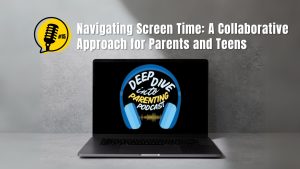In today’s digital world, initiating a conversation about screen time with your child is essential for fostering healthy habits. Clayton Cranford’s Screen Time Standoff provides valuable guidance on how parents can approach these discussions with empathy, strategy, and effectiveness. This article explores actionable steps to create meaningful dialogues that build trust and understanding while equipping families with the tools to handle digital challenges.
The Importance of Communication
Open and honest communication is the foundation of any successful parent-child relationship. When addressing sensitive topics like excessive screen time, it’s not just about what you say—it’s about how you say it. The goal is to ensure your child feels comfortable sharing their thoughts without fear of judgment or punishment. Effective communication fosters understanding, reduces resistance, and builds a pathway to mutual respect.
Self-Reflection: A Necessary First Step
Before initiating the conversation, evaluate your own habits. Ask yourself:
-
Are you modeling the behavior you want to see in your child?
-
Do you excessively use your phone or other devices during family time?
-
Are you using technology as a means of escape?
By reflecting on these questions, you gain insights into your own behavior, which helps you approach the discussion with greater empathy and authenticity. Recognizing how your habits might influence your child’s perceptions creates an opportunity to connect on a deeper level. For instance, when a parent acknowledges their own reliance on devices, it can encourage children to view the conversation as a shared journey toward healthier habits. This self-awareness builds trust, as children see that their parents are not merely dictating rules but are also committed to improving together. Self-awareness allows you to recognize how your habits may influence your child’s perceptions and actions, setting the stage for a more effective and relatable conversation. Demonstrating self-awareness can set a powerful example for your child and establish a shared commitment to healthier habits.
Timing Matters: Choose the Right Moment
Timing is crucial when discussing screen time. Select a moment when your child is relaxed and free from distractions. Cranford suggests informal settings—such as car rides or outings for ice cream—to create a low-pressure environment where your child feels safe to open up. For example, during a quiet drive home, a parent might ask casual questions about their child’s favorite games, sparking a natural and open dialogue. These informal moments often encourage children to share their thoughts without feeling put on the spot, building trust and understanding. For instance, one parent shared how an ice cream outing became a turning point in their relationship. During the drive, the child opened up about their struggles balancing schoolwork and gaming. This unexpected moment of honesty paved the way for a deeper understanding and collaborative solutions, demonstrating how such settings can reduce tension and foster open communication.
Choosing the right setting doesn’t just ease tension; it also demonstrates that you value your child’s time and feelings. This thoughtful approach makes it easier to discuss potentially sensitive topics without conflict.
Removing the Pressure: It’s Not a Battle
Discussions about screen time should not feel like a power struggle. Avoiding such dynamics is essential because power struggles often lead to resentment and defensiveness, making it harder for children to engage openly. Instead, fostering a collaborative approach emphasizes mutual respect and shared problem-solving, which strengthens the parent-child bond. By focusing on understanding rather than imposing authority, parents create an environment where children feel valued and are more likely to embrace healthy changes willingly. Avoiding a power struggle helps build trust and ensures the focus remains on understanding rather than winning or losing. This approach fosters a collaborative environment where both parents and children feel heard, ultimately strengthening the parent-child relationship. To create a productive dialogue, it’s vital to remove the focus from restrictions and rules.
Set Clear Intentions
Begin the conversation by clarifying that it is not about punishment or setting new limits. For example, you might say:
“This conversation isn’t about changing your screen time rules. I just want to understand your perspective.”
By removing the threat of immediate consequences, you foster a trusting environment where your child feels more comfortable expressing themselves. For example, one parent shared that by starting a discussion without mentioning rules or restrictions, their child opened up about the pressures of staying connected with friends through gaming. This understanding helped the parent navigate future conversations with more empathy and collaboration.
By clarifying your intentions, you set the stage for a conversation focused on mutual understanding rather than compliance. This can make a significant difference in how your child perceives the dialogue and their willingness to participate.







